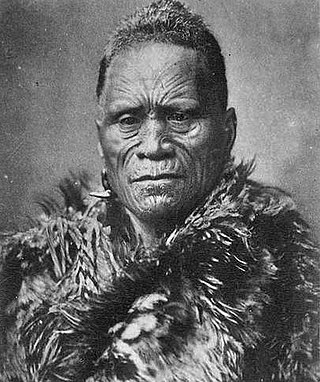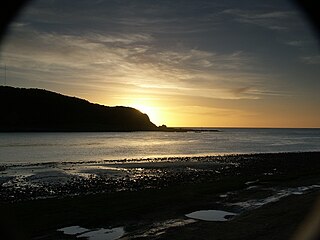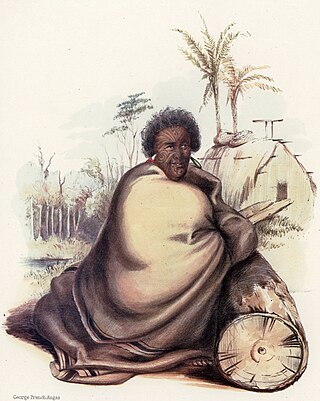List of honours
-
 Chevalier de la Légion d'honneur (France) – 2011.
Chevalier de la Légion d'honneur (France) – 2011.
Te Rongotoa "Tia" Barrett previously known as John Richard Te Rongotoa Barrett (24 July 1947 – 15 November 2009) was a New Zealand diplomat of indigenous Ngati Maniapoto and Waikato extraction from the Tainui iwi. [1] He was director of the Māori Policy Unit at the Ministry of Foreign Affairs and Trade (MFAT).
Mr Barrett joined the Foreign Ministry in 1973. He was High Commissioner to the Solomon Islands and Fiji, and had been posted to New Caledonia, France and Tonga. He spoke French fluently. [2]
He was New Zealand's first Māori High Commissioner to Rarotonga. He was High Commissioner to the Cook Islands at the time of his sudden death in Middlemore Hospital in Auckland on 15 November 2009 following a short illness. [3]
Tia Barrett grew up in Aria, Waikato. He is survived by his second wife, Theresa, and his two children, Caroline and Nicholas.

Tainui is a tribal waka confederation of New Zealand Māori iwi. The Tainui confederation comprises four principal related Māori iwi of the central North Island of New Zealand: Hauraki, Ngāti Maniapoto, Ngāti Raukawa and Waikato. There are other Tainui iwi whose tribal areas lay outside the traditional Tainui boundaries – Ngāi Tai in the Auckland area, Ngāti Raukawa ki Te Tonga and Ngāti Toa in the Horowhenua, Kāpiti region, and Ngāti Rārua and Ngāti Koata in the northern South Island.

Waikato is a local government region of the upper North Island of New Zealand. It covers the Waikato District, Waipa District, Matamata-Piako District, South Waikato District and Hamilton City, as well as Hauraki, Coromandel Peninsula, the northern King Country, much of the Taupō District, and parts of Rotorua District. It is governed by the Waikato Regional Council.

Te Kūiti is a town in the north of the King Country region of the North Island of New Zealand. It lies at the junction of State Highways 3 and 30 and on the North Island Main Trunk railway, 80 kilometres (50 mi) south of Hamilton. The town promotes itself as the sheep shearing capital of the world and is host to the annual New Zealand National Shearing Championships.

Tāwhiao was leader of the Waikato tribes, the second Māori King, and a religious figure. He was a member of the Ngati Mahuta hapū of Waikato.

Te Awamutu is a town in the Waikato region in the North Island of New Zealand. It is the council seat of the Waipa District and serves as a service town for the farming communities which surround it. Te Awamutu is located some 30 kilometres (19 mi) south of Hamilton on State Highway 3, one of the two main routes south from Auckland and Hamilton.

Taumarunui is a small town in the King Country of the central North Island of New Zealand. It is on an alluvial plain set within rugged terrain on the upper reaches of the Whanganui River, 65 km south of Te Kuiti and 55 km west of Turangi. It is under the jurisdiction of Ruapehu District and Manawatū-Whanganui region.

Ōtorohanga is a north King Country town in the Waikato region in the North Island of New Zealand. It is located 53 kilometres (33 mi) south of Hamilton and 18 kilometres (11 mi) north of Te Kūiti, on the Waipā River. It is a service town for the surrounding dairy-farming district. It is recognised as the "gateway" to the Waitomo Caves and as the "Kiwiana Town" of New Zealand. Until 2007, Ōtorohanga held a yearly 'Kiwiana Festival.'

Ngāti Toa, Ngāti Toarangatira or Ngāti Toa Rangatira, is a Māori iwi (tribe) based in the southern North Island and in the northern South Island of New Zealand. Its rohe extends from Whanganui in the north, Palmerston North in the east, and Kaikōura and Hokitika in the south. Ngāti Toa remains a small iwi with a population of only about 9000. It has four marae: Takapūwāhia and Hongoeka in Porirua City, and Whakatū and Wairau in the north of the South Island. Ngāti Toa's governing body has the name Te Rūnanga o Toa Rangatira.

Kawhia Harbour is one of three large natural inlets in the Tasman Sea coast of the Waikato region of New Zealand's North Island. It is located to the south of Raglan Harbour, Ruapuke and Aotea Harbour, 40 kilometres southwest of Hamilton. Kawhia is part of the Ōtorohanga District and is in the King Country. It has a high-tide area of 68 km2 (26 sq mi) and a low-tide area of 18 km2 (6.9 sq mi). Te Motu Island is located in the harbour.
The King Country is a region of the western North Island of New Zealand. It extends approximately from Kawhia Harbour and the town of Ōtorohanga in the north to the upper reaches of the Whanganui River in the south, and from the Hauhungaroa and Rangitoto Ranges in the east to near the Tasman Sea in the west. It comprises hill country, large parts of which are forested.

The Māori King Movement, called the Kīngitanga in Māori, is a movement that arose among some of the Māori iwi (tribes) of New Zealand in the central North Island in the 1850s, to establish a role similar in status to that of the monarch of the British colonists, as a way of halting the alienation of Māori land. The Māori monarch technically operates in a non-constitutional capacity with no legal or judicial power within the New Zealand government, but nonetheless, is a major political and cultural figure in the country for many of its 5 million people, wielding significant lobbying power and mana. Reigning monarchs retain the position of paramount chief of several iwi and wield some power over these, especially within Tainui.

Pōtatau Te Wherowhero was a Māori warrior, leader of the Waikato iwi, the first Māori King and founder of the Te Wherowhero royal dynasty. He was first known just as Te Wherowhero and took the name Pōtatau after he became king in 1858. As disputes over land grew more severe Te Wherowhero found himself increasingly at odds with the Government and its policies.
Ngāti Raukawa is a Māori iwi with traditional bases in the Waikato, Taupō and Manawatu/Horowhenua regions of New Zealand. In 2006, 29,418 Māori registered their affiliation with Ngāti Raukawa.

Rewi Manga Maniapoto (1807–1894) was a Ngāti Maniapoto chief who led Kīngitanga forces during the New Zealand government Invasion of Waikato during the New Zealand Wars.

The Battle of Hingakākā was fought between two Māori armies of the North Island, near Te Awamutu and Ohaupo in the Waikato in the late 18th or early 19th centuries, and was reputedly "the largest battle ever fought on New Zealand soil". One army was from the south of the North Island and the other was from the Tainui confederation of the central North Island. Both armies included allied forces from several different hapū and iwi.
Diggeress Rangituatahi Te Kanawa was a New Zealand Māori tohunga raranga of Ngāti Maniapoto and Ngāti Kinohaku descent. At the time of her death she was regarded as New Zealand's most renowned weaver.

Te Mahuki (c1840–1899) was a notable New Zealand tribal prophet who believed he was an Israelite sent to find the promised land. Of Māori descent, he identified with the Ngāti Kinohaku and Ngāti Maniapoto iwi. He was born in Te Kumi, King Country, New Zealand.
Ōtewā is a rural community in the Ōtorohanga District and Waikato region of New Zealand's North Island.
Rangitoto is a rural community in the Waitomo District and Waikato region of New Zealand's North Island.
Wairangi was a Maori rangatira (chieftain) of the Ngāti Takihiku hapu of the Ngāti Raukawa iwi in the Tainui tribal confederation from the Waikato region, New Zealand and the ancestor of the Ngāti Wairangi hapū. He probably lived in the mid-seventeenth century.